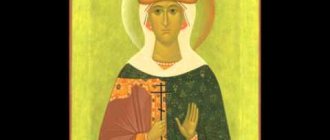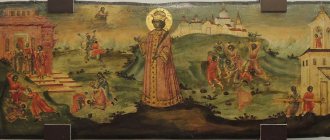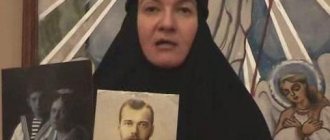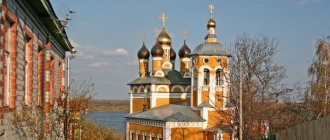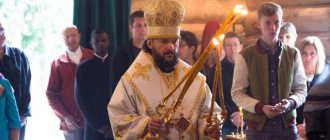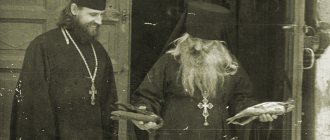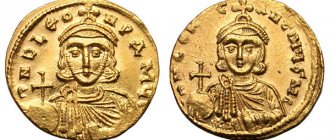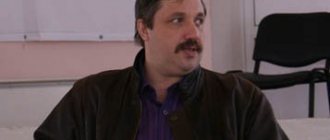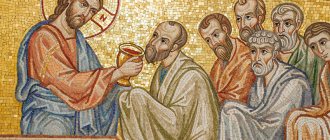Why do happy and successful people give up everything and go to a monastery? Can a modern person follow the path of the monks? We bring to your attention an interview with nun Juliania (Denisova), a nun of the St. Elisabeth Monastery (Minsk), included in the book “Monks” by Yulia Posashko, which is published by the Nikeya publishing house .
45 bags, 35 pairs of shoes, a closet of cosmetics, your own separate apartment - eat, drink, be merry! And in my soul there is a cry: “I can’t do this anymore!” Irina Denisova, a famous regent throughout Belarus, entered the monastery at the peak of success. She raised three children, achieved recognition in the world of music, achieved everything... They even made a film about her - “Regent”. And a few years later the second film was released - “Nun”...
Our story is about how a woman who had never dreamed of it came to monasticism...
Life according to plan
— Mother Juliana, in the film “Nun” [1] You said that you didn’t even think about monasticism, but decided on it suddenly, in three days. What happened in these three days?
“I had to answer this question many times: how is it that you didn’t intend to, but then got ready?” I still don’t know how to explain this correctly...
Those three days were the tip of the iceberg; this is what my whole life has really been leading up to. Now, as if through a transparent glass, my entire previous fate became visible to me as a preparation for this final event.
There were times when I went in the exact opposite direction from God. You know, now I think that the Lord gives the opportunity to choose, some variability to every person. A person always strives to go out of his way and slides into sin, but the Lord “catches” him there and looks for another path for him.
- Is that what happened to you?
- Yes. My soul has always been a seeker, ever since my youth. I tried to “catch” God’s providence, even being an unbeliever and unbaptized. I wanted some kind of purity... How was I to know then that such categories do not live in a sinful being who does not know God, does not turn to Him, lives only by himself: all these “I, I, I” leave their mark from childhood ...
Church choir according to the Butusov principle
– Is a director in a church choir primarily a leader?
You have such a friendly team, but perhaps you still need a clear chain of command? – We have a peculiar situation in the choir, I cannot impose it: do it this way, and you will have it like we have. You just need to be friends. Everyone in our team is very different, but all the choristers consider unity and conciliarity to be the main thing in the choir.
We were making an album for the 20th anniversary of the choir, and each one was filmed separately, no one knew what the previous one was talking about. But when they put it together, it turned out that everyone was talking about the same thing: we are friends, we are family. And it is very dear to me. How to achieve this? Just to love.
Like Butusov in a song that I really like: “All you need is love.” There is a decoding of what love is: not this snotty romantic feeling that is there today and gone tomorrow, but true love.
– Does burnout happen in the choir?
- Certainly. What to do? Don't make any decisions. You didn’t put yourself here, it’s not your choice. This is God's choice. Every singer understands that he is in the choir for a reason. If you feel like it’s not your thing, or you’re bored, you have to be patient, you can’t throw things like that around.
But in our choir such questions do not arise. Precisely because there are other things that hold it together. Firstly, this is professionalism, and secondly and most importantly, human relations. We’ve had a lot of people go through the choir, but some didn’t work out. But those who exist now are a wonderful community, simply God’s mercy.
The Road Through the Occult
—What happened in your inner life before you came to faith?
— Creativity driven inside. In general, a good question: how can you live when you don’t know God, what kind of inner life? There was some kind of secret life of the soul and a search for meaning. Inside - tragedy, search, dissatisfaction... Everything did not satisfy.
— Have you ever been tempted to replace the meaning of life with children and work?
- The meaning of life is in children, in service, in work - this is all earthly. My soul felt that it was not from here! But she couldn’t formulate it. So I searched wherever possible. And in the early 90s - as always at the turn of eras - suddenly the evocation of spirits, occultism, astrology became very popular, the names of Blavatsky and the Roerichs surfaced. Literally a month after I was baptized, I was offered a subscription to Pavel Globa’s school of astrology...
Nobody really knew what it was, but the intelligentsia buys into such “things.” The devil understands the social structure of man and acts in the terminology that is close to him. In my case, it was such a choice: “this is for the elite, some factory worker won’t understand, but you’re not just anyone, you’re a highly cultured person!”
We drew up horoscopes, practiced palmistry, and by the time my youngest son Ignat was diagnosed with terminal kidney cancer, we were undergoing medical astrology - “health correction according to the horoscope.”
- What a cruel irony: it seems like they were learning to treat people, but their own children were getting sick...
- Yes, my children suffered greatly from all this - they suffered from almost every disease there is, all the hospitals in Minsk were known to me. For some reason, it’s amazing! — I didn’t connect this with my astrology studies.
It seemed to me that this was temporary: a little more, and I would find some kind of “philosopher’s stone”, and all these troubles would disappear. The biggest mystery in my life today is how the Lord pulled me out of all this!..
The astrological stage of my life was the most intense and leading to some kind of catastrophe. I felt it with my whole being, I knew that something terrible was about to happen.
Three weeks before I turned to God, I wrote this poem:
My heart
The heart sleeps in the shackles of boredom - Apparently it feels more comfortable this way. And nothing will touch him, will not free him from captivity: neither thinking about the sad, nor news about the secret. Even the terrible face of death does not wake him from sleep. I have separated myself from my heart - Here I live, I sing, I moan, I lament, like a merchant, About universal indifference, With a battered sleeping heart, Feeling nothing, Without dreaming, without suffering, Knowing everything until the grave. How easy it is for me to pretend that there are fires and storms in my chest! It doesn’t cost me any effort - Everyone is “happy to be deceived.” I know: with a restless heart, with a numb soul, I will cry out as much grief as I have never known before. I know: troubles are not mistakes, They cannot be corrected. Where is the One Who will not allow the Evil Heart to die?!
This was in early December 1991. And a week later I learned Ignat’s diagnosis...
My son’s illness brought me to God, that’s absolutely certain. This was the last “button” that the Lord pressed.
“SHE REVIVED AN ICON IN OUR CHURCH”
The life of one person, a life like the life of Mother Juliana, is an illustration of the life of our Church!
Metropolitan Filaret of Minsk (Vakhromeev)
On February 18, 1981, Moscow theological schools and the Trinity-Sergius Lavra saw off Maria Nikolaevna Sokolova, secretly tonsured nun Juliania, an inspired icon painter, an experienced restorer, and the head of an icon painting circle.
Saint Alexy of Moscow
Nun Juliania was born in Moscow on November 21, 1899 in the family of priest Nikolai Aleksandrovich Sokolov, a graduate of the Moscow Theological Academy. From the age of 14 she became the spiritual daughter of the Moscow elder, righteous Alexy Mechev. In the early 1920s. Hieromartyr Sergius Mechev blessed nun Juliana to engage in icon painting. During the period 1920–1940 she made copies and sketches of ancient frescoes and icons in northern monasteries, temples, museums and private collections. These years were a time of accumulation of rich knowledge and material in the field of icon painting.
In the 1930s With the blessing of Saint Athanasius of Kovrov (Sakharov), nun Juliana creates the “Image of all the saints who shone in the Russian land.” She addresses this topic throughout her life.
In 1946, Maria Nikolaevna (nun Juliania), as an experienced icon painter, received an invitation from the Lavra governor, Archimandrite Guria (Egorov), to participate in the restoration. For more than 30 years she worked at the monastery of St. Sergius. One of her first major creative works in the Lavra was the painting of the Serapion Tent. According to an ancient monastic legend, on this site there was a wooden cell of St. Sergius, and therefore the theme of the paintings is dedicated to his wonderful life. The walls and vaults were painted by nun Juliania in 1949. She also painted the icon “Appearance of the Most Holy Theotokos to St. Sergius” for the Serapion Tent in 1950. In the same years, for the Nikon chapel of the Trinity Cathedral, nun Juliana created an image of St. Nikon with a life in 20 stamps, painted icons of St. Sergius and St. Alexis and icons for the canopy over the relics of St. Nikon, including 18 icons depicting the disciples of St. Sergius, as well as painted an icon of St. Sergius with his life at the shrine with his relics.
In 1952–1954 wrote icons for the iconostasis of the Sergius Church in Fergana.
In 1955, nun Juliania painted the Intercession Academic Church with a group of young artists - her students - I.V. Vatagina and E.S. Churakova. The church's paintings were lost during a fire on September 27, 1987. Her paintings have been preserved in the altar on the altar barrier - life-size images of saints and saints and an altarpiece of “The Resurrection of Our Lord Jesus Christ” painted on glass (now located in the Refectory Chamber under the Intercession Church). For the iconostasis of an academic church of the 17th century. nun Juliana painted 11 icons, as well as icons for the royal doors and deacon doors.
In 1955–1957 in the Lavra, in the church of St. Sergius, the governor Pimen (Izvekov) built two side chapels - in the name of St. Seraphim of Sarov and in the name of St. Joasaph, Bishop of Belgorod. Nun Juliana completed the design of the iconostasis and painted all the icons for the two chapels.
It is difficult to appreciate the titanic work of nun Juliana on the restoration of the Lavra. Father Nikolai (Samsonov) said that he and Maria Nikolaevna (nun Juliania) were “pioneers,” one of the first to begin restoring wall paintings and icons after the opening of the Lavra in 1946. “There was great desolation,” said Father Nikolai. “It was only later that Maria Nikolaevna had assistant students, but at first she was alone.”
In 1973, restoration of the iconostasis of the Church of St. Sergius and the paintings of the Refectory Chamber was carried out. Her disciples came to help - monks of the Trinity-Sergius Lavra: Archimandrite Bartholomew (Kalugin), Father Alypiy, now Archbishop (Pogrebnyak), Archimandrite Boniface, in the schema Zacharias (Potapov), Archimandrite Eleutherius (Didenko) and others.
Throughout her life, nun Juliana saw in the church community a misunderstanding of the ancient icon; Preference was given to pictorial images. To establish and understand icon-painting traditions, it was in the Lavra, among the brethren of the monastery, among the future clergy, that in 1957 nun Juliania headed the icon-painting circle within the walls of the MDA.
Nun Juliania tried to convey her love for the ancient Russian icon to the students of Moscow theological schools - future shepherds of the Orthodox Church. She repeatedly gave thematic lectures to large audiences at the Academy and Seminary, revealing the artistic merits and depth of theological content of the ancient icon.
During the 23-year period of leading the icon painting circle, nun Juliana raised many students. The students found in her not only a recognized master, but also a benevolent, caring teacher, whose works were highly appreciated by the Russian Church. To facilitate the development of icon painting techniques, nun Juliana made many educational samples. She put a lot of effort, time and love into this. She did a great job of drawing up a program and method for teaching icon painting, and prepared a written work on icon painting techniques.
Saint Nicholas of Japan
In 1970, Maria Nikolaevna took secret monastic vows in the name of the holy martyr Juliana. Generosity of soul, exceptional tact and high culture were combined in her with a truly monastic inner disposition. Imitating the holy icon painters of antiquity, she accompanied her reverent work with fervent prayer and fasting.
Farewell to Mon. Juliana of Patriarch Pimen
Nun Juliana reposed in the Lord on the second day of the Presentation of the Lord, when the memory of St. Nicholas of Japan, whose icon Mother painted for his canonization, is celebrated.
Farewell to Mon. Juliana of Metropolitan Philaret
Farewell to nun Juliana became evidence of her veneration. The funeral service was led by the abbot of the monastery. His Holiness Patriarch Pimen, Metropolitan Filaret (Vakhromeev), confessor of the Lavra Archimandrite Kirill and the brethren of the monastery, teachers and students of the Academy said goodbye to nun Juliana.
Farewell to Mon. Julian of the Lavra brethren
"God's Miraculous Help"
Lidia Nikolaevna Aldoshina , sister of nun Juliania:
— The ill-fated year of 1917 arrived. I finished my last year at the gymnasium, and Maria, after graduating from the gymnasium, in the fall she entered Rerberg’s art studio, where she successfully worked on plaster and studied human nature.
Revolutionary events took place in February. A ferment of minds began and the emergence of different parties. People expected an armed uprising.
At the end of our street, on Shvivaya Gorka, on the bell tower of the Church of the Holy Great Martyr Nikita, a cannon was placed from which they fired at the Kremlin. There were cadets in the palace defending the Kremlin. They were all killed. Armed soldiers were running through the streets. Many buildings came under fire. We were all in great fear, not knowing what lay ahead. Soon after the October Revolution, famine occurred in Moscow. We had moments when we didn’t see bread for two or three months. The card system did not apply to us, since my mother fell into the category of deprived people for being both the wife and daughter of a priest.
Public canteens were open, where we went to bring home herring head soup. There was no sugar, no tea, not even salt or soap on sale. We had the idea to leave Moscow and go somewhere to escape starvation. Maria went to Father Alexy for a blessing and heard the following words: “If we run away from the trials God sends us, they will overtake us where we run, so it’s better to be patient here.”
Soon my mother fell ill with typhoid fever. Following her mother, her younger sister Sima fell down. She was diagnosed with a then-current fever called “Spanish flu”; her temperature reached 41 degrees. She lay there like a sheet and was delirious. A few days later, Maria fell ill with pneumonia. I was the only one left among them capable of moving. In order not to completely freeze, I wore winter outerwear, and we slept in it. There was no treatment; everyone lay there, surrendering themselves to the will of God.
After two weeks, my patients began to get better little by little.
Remembering now this period in our lives, I believe that it was God’s miraculous help. We felt this help throughout our lives, and especially on Thursdays, the day dedicated to St. Nicholas. During this difficult time, we had neither work nor income.
“Mary’s life during the years of persecution always walked along the edge of a sword...”
Vladimir Vladimirovich Bykov , spiritual child of Saints Alexy and Sergius Mechev:
“I will not remember the icon painter Maria, but the sister of the Marosei community, created by the Moscow elder Father Alexy, about the amazingly spiritual person Maria, whom, by the great will of the Lord, I met in the Church of St. Nicholas in Klenniki. I first came to the Moscow elder Father Alexy in 1922 and became his spiritual son, and from 1924 to 1941 - the spiritual son of Father Sergius Mechev, so the life of Maria Nikolaevna Sokolova in the community was clearly visible to me.
Through constant prayer and complete dissolution in love for people, Father Alexy came to the eldership and became a Moscow elder, a good shepherd for many, many. And so, Mary comes under the spiritual guidance of such a shepherd, becoming his spiritual daughter and sister of the community. Father Alexy put everything possible into Mary’s open soul: the great spiritual teaching of the Orthodox Church, deep comprehension of the love of God, love for people, humility, and a heartfelt understanding of the word of God. The Lord gave deep faith and talent as an icon painter, multiplied by her prayer.
I knew Maria Nikolaevna since 1922, but our first conversation took place in 1929 in her apartment, on Bolshaya Kommunisticheskaya Street, near Taganka. The conversation was long and marked the beginning of a friendship.
An intelligent, observant and talented person, she had enormous inner spirituality, the gift of constant prayer, and carefully studied the word of God. Delving into, comprehending every word, she generously shared with us what she read, soulfully explaining and answering the questions asked.
After the death of Elder Alexy, Father Sergius became the spiritual father of the community. Seeing the high spirituality of Maria Nikolaevna, he perceived her not only as a spiritual daughter, but also as a friend and adviser on many issues, and in difficult moments in the life of the community he consulted with her.
Father Sergius was in prison, in exile, under a ban on coming to Moscow, and he wrote and told us, members of the Marosei community: “If you have difficulties, go to Maria Nikolaevna - she will give you the right advice.” And we, the brothers and sisters of the community, went to Mary and always received a clear and precise answer.
Few of the sisters and brothers knew that Father Sergius created a “think tank” that controlled the community. It included Maria Nikolaevna, Sima Solovyova, Tatyana Alekseevna Davydova, the wife of Vasily’s father, and Elizaveta Zamyatina.
Such a council was created at the direction of Father Sergius, for he was constantly either in prison or in exile. And the community lived both before and after the closure of the temple in 1932. The decisive word belonged to Maria Nikolaevna, but all decisions were communicated to Father Sergius. In 1928, Maria Nikolaevna created an icon painting circle in the community, and it operated until 1939.
Ferapontov Monastery. 1930s
In 1933, Maria Nikolaevna and my wife Elena went to the Novgorod and Pskov regions to make sketches of frescoes and icons. The trip was difficult: monasteries and churches were closed, some were destroyed; museum workers were reluctant to allow, or even did not allow, work; in some places they were guarded by guards and were allowed in only for money; sometimes by candlelight, at night, Maria and Elena made sketches. Maria brought a large folder of sketches of icons and frescoes to Moscow, which I examined with interest.
M.N. Sokolova. 1943
The memories of how the image of All the Saints who shone in the Russian Land were still alive in my memory. Maria was about 30 years old at that time; she looked through hundreds of lives of saints, legends, articles, and books. She picked up huge iconographic material. In terms of the amount of spiritual knowledge and work invested by Mary, the image of All Russian Saints is equal to, and perhaps surpasses, any doctoral dissertation. Hundreds of sketches and sketches were made, many, many hours were spent in prayer, thought, and doubt. Maria consulted with Father Sergius, with Father Boris (Kholchev) and with Bishop Afanasy (Sakharov) in those short periods of time when he was free.
Having created the image of All Russian Saints, Maria Nikolaevna Sokolova no longer became an icon painter of the Maroseya community, but an icon painter of the Russian Orthodox Church. The talent of an icon painter, endowed in her by the Lord, fully blossomed, and then more and more perfect icons began to appear. Each icon created by Mary contains part of the spiritual inheritance passed on to her by Elder Alexy and Father Sergius, as well as a deep prayer to God by Mary herself.
Iconostasis of the temple in Fergana
Maria Nikolaevna was a closed person and rarely, rarely revealed the secrets of her soul, but we loved each other and were friends - and sometimes her soul was revealed, and then she told us her most intimate, beloved, joyful, spiritual aspirations or sorrows. Throughout her life, one cherished spiritual dream passed through - to become an icon painter nun. At that time, Father Sergius did not advise her to become a monk. But, not being a nun, she lived in our vain and dangerous world as a real nun.
Cathedral of Russian Saints. 1950s
Maria Nikolaevna's life was in danger all the time. They wanted to arrest her twice.
The Lord, by His mercy, preserved it for us sinners, preserved the icon painter for the Russian Church. More than once Maria saw herself being followed, but nothing stopped her. She went into exile many times to Father Sergius and Bishop Athanasius in the 1930s, and this was very dangerous at that time. During the years of persecution, Mary’s life always walked along the edge of the sword, but the Lord invisibly guarded her along all the paths.
Icons painted by Mary (Mother Juliana) are the great wealth of the Russian Church and, being in Moscow churches, in the Trinity-Sergius Lavra, Tashkent, Fergana, Vladimir, Novy Oskol, Orel, Rybinsk, in the Baltic states and in the homes of many Orthodox Christians, they sanctify us Christians with the light of faith and goodness.
“The benefit from the communication was great. The soul came to life"
Elizaveta Aleksandrovna Bulgakova , spiritual child of the Hieromartyr Sergius Mechev:
— I met Maria Nikolaevna when I was already 21 years old. Father Sergius wanted this. I needed to communicate with a living spiritual person. I didn’t have this, there were only spiritual books in which I got confused. There was no access to Father Sergius: he had already been arrested and lived in the small town of Kadnikov, Vologda region. He was, as always at that time, under surveillance. And not everyone went, but the closest ones. Sensing my need, he wrote to me asking me to get closer to Maria Nikolaevna, to be frank with her and to trust her as much as he did. I suffered alone, I felt affection for Maria Nikolaevna from childhood, and it was not difficult for me to obey him in this. I remember receiving the letter back in the winter, and approached her during the last Liturgy served at Maroseyka. It was on Annunciation Day 1932. All the fathers were taken: in 1929 - Father Sergius, in 1931 - Father Boris (Kholchev), then they came to us from the Podkopaevsky church, they were of the same church direction, and they were taken. And Father Alexander “hunchbacked,” as he was called, served that last Liturgy. He was already elderly, hunchbacked, apparently with a bad heart - swollen. He knew that they would take him, but he still came. The whole church took communion. And indeed, the next night they took him.
From the very first visits I began to receive great benefit from her; she put me on the right spiritual path. I worked, just like her, in a publishing house and was not tied down by hours. So I began to be useful - to carry out many assignments. They didn't use the phone back then.
I don’t know when she got up, but from morning until lunch she did publishing work. At the same time, there was also a reception of people who came for all sorts of advice. I usually came to talk about internal needs. Then Maria Nikolaevna gave instructions for the day: to whom - to carry a note, to whom - to talk orally. All of Maroseyka was divided into separate groups, so that among those who did not know the divine service, there was still one person who knew. Canonarch Maria Stepanovna wrote down the entire order of the service in detail for each such group. Father Sergius wanted the services on Maroseyka to continue. Each group was given a day on which, if possible, they gathered and read the all-night vigil, the hours and the pictorial.
Every day, at 5 pm, Maria Nikolaevna went to one of the groups. After the service there was a modest meal, during which Maria Nikolaevna read something valuable and interesting. At that time, the memories of Father Alexy were still little known; she always read them in all groups, read the general letters of Father Sergius. These were very valuable evenings. She had all her evenings dedicated to this, even Sundays. She had a clear plan: to whom, when and with what she was going. Almost always, after this, one of those present accompanied her home to talk along the way.
In the Marose community there were groups in which, under her leadership, they studied the Bible. It was very interesting. They wrote reports on what they read. A small part was worked through, but it remained alive for the rest of its life. I thought that this only happened to our group - everyone knew how to remain silent then. But it turned out that there were several such groups.
Maria Nikolaevna lived with her mother Lidia Petrovna on Bolshaya Kommunisticheskaya in a two-story old house with a high wooden gate and a gate, which, to our great regret, creaked. On the second floor, in the left corner of the room, fenced off on both sides with cabinets, there was Maria Nikolaevna’s corner. There is a table in the corner. During the service, he was covered, as in church, according to the holiday: on the feasts of the Mother of God - with a blue napkin, on Sundays - with a white one, and so on. Small icons of each holiday were painted. The icon was placed on a table, in front of it was a lamp and the Gospel, flowers or a pine branch in winter. Liturgies were rare, and I attended only once.
Father Sergius blessed some of those in need of spiritual support to turn to her with complete frankness and trust her just as he did, but she was only 32 years old - and she bore this, and the benefit from communication was great. The soul came to life.
In 1938, Lydia Petrovna, Maria Nikolaevna’s mother, died.
Lydia Nikolaevna was getting ready to leave Moscow. Maria Nikolaevna, with the blessing of her father Sergius, went to Rybinsk, where the blind mother Ksenia lived, even bishops turned to her. When Father Sergius was asked where he should register, the answer was: “The schema, the seclusion, is waiting for him. He is a holy martyr." And she said to Maria Nikolaevna: “Martha and Maria - Martha and Maria.” And Maria Nikolaevna realized that she should not stay in Moscow, but unite with her sister.
I met her already in Zagorsk (as Sergiev Posad was called then - Ed.), when I was released after arrest (four months in solitary confinement and a month of waiting for someone to finish you off were like fire). The documents were returned completely clean - there was no trace that I had been there. It was a miracle through the prayers of Father Sergius. But to come to Moscow, a special pass was required. They didn't give it to me. And willy-nilly I ended up in Zagorsk with some kind of train. I easily found the house where Maria Nikolaevna lived, although it was already dusk. The door was not locked. She entered the kitchen. Maria Nikolaevna's corner was fenced off with a dark red antique curtain. The curtain opened slightly and Klavdia Nikanorovna looked out. She and Maria Nikolaevna read the all-night vigil, and I joined in. Maria Nikolaevna never interrupted the service unnecessarily. When they finished, of course, questions and stories started pouring in about what they had experienced in those first months of the war. Then I noticed Maria Nikolaevna had a bag over her bed. It turned out that it was for the poor. When they receive the bread, they cut off a piece and put it in this bag.
“Everything seemed like a miracle to me”
Irina Vasilyevna Vatagina , icon painter, restoration artist, professor at PSTGU:
— It was 1949. I had just graduated from the V.I. Art Institute. Surikov. I went to Zagorsk to write sketches with the hope of finding Maria Nikolaevna there. I wrote during the day, and in the evening, during the all-night vigil, I met a short woman with large, beautiful, unusually radiant eyes. I thought that this was Maria Nikolaevna. I spent the night with my close friends the Churakovs in Semkhoz (near Zagorsk). It turned out that Katya and Masha Churakov know Maria Nikolaevna and her entire family well, that these are their neighbors in Semkhoz and that they will introduce me to Maria Nikolaevna.
On the appointed day, I arrived at Semkhoz with a backpack of my works. Masha and Katya took me to Maria Nikolaevna. Of course, that woman with beautiful radiant eyes was Maria Nikolaevna. I must say that before that I spent 2 years working at the Tretyakov Gallery in icon painting and restoration of icons under the direction of N.A. Demina and I.A. Baranova. I made several copies of the icons. It was these copies that I brought to show Maria Nikolaevna. She approved of them.
Nun Juliana in the Serapion Tent
After we met, she went to her dacha in Tarusa. I painted landscapes, but without any joy. I felt like I was wasting my time. And suddenly a letter from the Churakovs: “Where have you been? We've been looking for you for a long time. Maria Nikolaevna invites you to help paint the Serapion Chamber.” I lost my mind!.. I arrived in Zagorsk on August 4th. Day of Angel Maria Nikolaevna. Maria Nikolaevna was 50 years old. She seemed very old to me then (I was 24 years old).
A completely unusual, happy life began. Maria Nikolaevna, Sergei Sergeevich Churakov, Katya and I worked on the paintings. Katya and I did the simplest work. Gunpowder was made from cardboard for transferring to the wall, and paints (Ferapontov stones) were ground. Everything was interesting to us. Then they began to take part in revealing the walls with primary colors. I remember that three times they cleaned and again opened the vault of the Serapion Chamber - the sky. We achieved the right tone. Maria Nikolaevna took an active part in this and encouraged: “Just think, for the third time we are redoing it with our own hands, not hired hands.” Monks constantly came to see our work. Especially often - Father Sergius (Golubtsov) and the governor, Father John. His Holiness Patriarch Alexy I visited twice.
Murals of the Serapion Tent
In moments of rest, Maria Nikolaevna read something instructive to Katya and me, explained the service, and generally worked to eliminate our illiteracy.
In painting the Serapion Chamber, Maria Nikolaevna relied on her copies from Ferapontov. In the evening, when everyone went home, I stayed to copy the finished fragments of the painting. In the future, these copies helped me many times in my work. Every evening, when I went to bed, I wanted the night to pass quickly and another day as happy as the previous one to begin. It was some kind of special world. And also monastic services, and the shrine of St. Sergius.
Murals of the Serapion Tent
You have to imagine that time. Today's youth don't understand. While it's kind of a desert. It seemed that there was no way to work for the Church. A restorer of icons at a museum—that’s the limit. My teacher from the Tretyakov Gallery, I.A. Baranov said with sadness: “If you and I worked for the temple, how our hearts would burn!” But these were just pipe dreams. And suddenly!..
Appearance of the Mother of God to St. Sergius. Icon of the Serapion Tent
Of course, everything seemed like a miracle to me. Yes, that's how it was. Not long before that, I read A. Yakubovich’s book about Father Alexy Mechev (now published, then it was a typescript). The book made a strong impression on me. And now I find out that Maria Nikolaevna is one of the closest spiritual daughters of Father Alexy and Father Sergius.
The Serapion Chamber was completed by October. I went to work at the Trinity Cathedral on the restoration of paintings. Maria Nikolaevna arrived every day at seven in the morning. After the fraternal prayer service, she and I climbed the scaffolding and, before the restorers arrived at 9 o’clock, we copied the feasts of the iconostasis. Maria Nikolaevna made copies of all the holidays, and I, under her leadership, made several. Maria Nikolaevna always copied icons whenever possible. The copies were small in size and did not claim archaeological accuracy. This was her work material. On Sundays I went to Maria Nikolaevna in Semkhoz. They did icon painting there.
And then, during class, they began to paint icons for the Church of the Prophet Elijah the Ordinary in Moscow.
Reverend Wonderworkers of All Russia. Icon of the Temple of the Prophet Elijah the Ordinary
Maria Nikolaevna enjoyed enormous authority both spiritually and as an icon painter. Before my eyes, the attitude of the clergy towards icon painting changed radically. This is the great merit of Maria Nikolaevna. Her many years of work in the icon-painting class of the Moscow Theological Academy gave a lot for the education of the younger generation of clergy. Most modern icon painters are students of Maria Nikolaevna (nun Juliania) or students of her students. And at first she was alone.
M.N. Sokolova with I.V., Vatagina and E.S. Churakova
"She was sent on my life's path"
Ekaterina Sergeevna Churakova , icon painter, restoration artist of the Central Artistic Academy of the Moscow Academy of Arts:
“I knew Maria Nikolaevna, nun Juliana, for many years.
I became close to her when I lost my dad. Everything in my soul was broken. I saw death for the first time. My beloved father died in my arms. It was a terrible shock for me.
I couldn’t come to my senses for a whole year. Maria Nikolaevna took pity on me, brought me closer to her and was very supportive. She was sent on my life's path. Maria Nikolaevna directed me to church art. She took me on as her assistant in painting the fraternal refectory, where I worked on ornaments, and also took part in painting the Serapion Chamber together with Irina Vasilyevna Vatagina. My older brother Sergei was working at the Lavra at that time on the restoration of the paintings of the Trinity Cathedral together with Bragin. Maria Nikolaevna consulted with Sergei when he came to the Serapion Chamber.
Appearance of the Mother of God to St. Seraphim. Icon of the Limit of St. Seraphim of the Lavra Refectory Church
Maria Nikolaevna was my spiritual mother. I came to her simply as an interview, as a revelation of thoughts.
When I entered her room, it was as if I was entering another world. There was some special condition there. And even just visiting her gave peace to the soul.
I worked with her both at the Lavra and at the Theological Academy. When we restored the paintings of the Refectory Church, Archimandrite Pimen (the future Patriarch) was the vicar. He came to us very often, encouraged us, told us something. He cared about what we ate and was generally very attentive. Our work progressed quickly. We worked for a month or two. The composition “The Last Judgment” and others were cleared.
Archimandrite Nikolai greeted me in the morning with the words: “Katya, to the Last Judgment!”
Then they began to make two side chapels in the same temple. I rubbed the paints and revealed the colors. Maria Nikolaevna was a hard worker. She worked so much that we could not even imagine.
Cathedral of the First Hierarchs of All Rus'. Metropolitan Lavra chambers. 1965
She didn't like to talk about herself. She was even secretive. She directed me to Father John (Maslov). Maria Nikolaevna traveled to the Glinsk Hermitage more than once.
She knew Bishop Sergius (Golubtsov), Archimandrite Alypiy (Voronov), abbot of the Pskov-Pechersky Monastery, Lavra Archimandrite Nikolai (Samsonov) well. They were all professional artists. They respected Maria Nikolaevna very much.
"This is an extraordinary person"
Irina Alexandrova Ivanova , art critic:
— Vasily Osipovich Kirikov always spoke about Maria Nikolaevna Sokolova with touching warmth, considering her his most faithful and devoted student.
Passion for the works of the Middle Ages filled both Kirikov and Maria Nikolaevna. They inspired each other, drawing strength and boundless joy from the treasury of this art, which gave them the opportunity to live and work selflessly.
For Kirikov, Maria Nikolaevna was a like-minded person on whom you could completely rely, tell everything to the end, meeting complete sympathy and understanding. In those difficult and difficult years, this was a great happiness.
Now we can only regret that we do not know in detail about their joint work, about how, while copying the Vladimir Icon of the Most Holy Theotokos of the 12th century in the State Tretyakov Gallery, they discussed a lot: writing techniques, the originality of the pictorial structure - and were in awe of the depth of this image.
Vasily Osipovich admired Maria Nikolaevna, repeating: “This is an extraordinary person, an extraordinary person...”.
Now, when the moral revival of our people is taking place, when the sense of national self-awareness is awakening with particular force, we treat with a deep sense of gratitude and respect those who in those years fearlessly and adamantly discovered amazing creative heights in our heritage - both in skill and in artistic imagery.
“Only by living spiritually and with prayer can one begin to paint icons”
Archimandrite Eleutherius (Didenko):
— First of all, I would like to thank the Lord for the fact that Maria Nikolaevna, nun Juliana, met us in our lives.
Nun Juliana left a deep imprint in my life. I would like to note that, first of all, she taught us to understand icons. Some of us did not understand this term itself: how does it mean to “understand an icon”?
Maria Nikolaevna said that the word of God is understood as one grows spiritually (after all, all the holy fathers note that as we fulfill the commandments of God, as we live a Christian life, the word of God is understood more and more by us). In the same way, the icon reveals to us insight into spiritual life. “Only by living spiritually and with prayer can one begin to paint icons or restore them.” I will forever remember this saying of hers, she often repeated it, and I still remember it to this day. Maria Nikolaevna said that the more the icon painter prays when painting an icon, that is, in other words, the more prayer is put into the icon, the more the painted icon will pour out this prayer and grace on those praying in front of it. This is the most direct connection.
Classes in the icon painting circle
She constantly painted icons and constantly prayed - she turned prayerfully to those saints whose icons she painted.
We asked Maria Nikolaevna: “What does constant prayer mean when working on an icon?” Because we have all observed: when you paint an icon, your attention is carried away by this writing, and the very words of the prayer disappear. And she confirmed that, in fact, when you paint an icon and feel the help of God or the help of this saint, this is prayer. But we must strive to never forget about the presence of God when painting icons, to feel Him. And she constantly reminded me of this: you have to get used to it, force it, force yourself. She herself carried this feat and commanded it to everyone who communicated with her, who learned from her to paint icons. Another peculiarity is that when communicating with Maria Nikolaevna, for some reason each of us believed that she distinguished him from others, as if you were closer to her than the others. And many years later I had to share it with everyone who attended the icon-painting class, and each of us felt such a special attitude from Maria Nikolaevna. Of course, we are very, very grateful to her for this. And we all believe in the holiness of Nun Juliana. We believe that she has the boldness to pray there for all of us, and, of course, first of all, for the icon painters. Each of us feels this gracious help. And the Holy Church teaches that those who remember the ascetics of prayer are helped in their deeds. Let us pray and have the boldness to ask her for this gracious help. The kingdom of heaven to her.
Classes in the icon painting circle
“It was she who revived the icon in our Church”
Archpriest Vladimir Vorobyov , rector of the church in the name of St. Nicholas the Wonderworker in Kuznetskaya Sloboda, rector of PSTGU:
— I recognized Maria Nikolaevna when I came to study at the seminary in 1978.
She was the first person I met on the stairs to the seminary, and almost immediately I realized that this was a holy person.
When I found out that Maria Nikolaevna was teaching the icon painting class, I immediately went there, although I understood that I would not become an icon painter. But Maria Nikolaevna’s personality was so attractive that there was no need to think about it - she was drawn there. I studied in the circle for a short time. It really was very warm and wonderful there.
Cathedral of Russian Saints. 1934
She was a meek, humble, silent person who always prayed. Because of the grace of her soul, the feat of her life was so fruitful. But, in addition, she is the spiritual child of Father Alexy Mechev and Father Sergius the Martyr, and one can say with all seriousness: she is an associate of Bishop Afanasy (Sakharov), because she embodied his plan for the icon of All Saints who shone in the Russian Land.
We have not yet been able to formulate for ourselves the meaning of her feat, her deed. After all, essentially speaking, it was she who revived the icon in our Church. It’s even hard to imagine how one person - a fragile woman - could do this. This is truly a miracle, and at what a time!.. At a time when our Church was persecuted, when it was so difficult, so scary to live. And at this time the revival of the icon occurs. And the Lord, by His grace, of course, helped her. Therefore, all her labors were surprisingly fruitful.
Press service of the MDA / Pravoslavie.ru
If you find an error, please select a piece of text and press Ctrl+Enter.
Call
— When did you first seriously think about monasticism?
- Seriously - only just before leaving for the monastery. And before that - what are you talking about! I am a very pragmatic person. Seraphim Vyritsky, or Father John (Krestyankin), who were blessed to become monks at the age of 8, and became monks after 50, could have dreamed of a monastery. Why should I dream? Even when the older children were already grown up, I said to myself: “Wait a minute! Can a person talk about a monastery if his youngest child is 13 years old? Can not".
Now I understand that it is not necessary to immediately be Seraphim of Sarov, that a person who comes to a monastery is no different from a layman. Only the desire to become a monk someday. Are we some kind of chosen people? Do they take any special people to become monks?
- Is not it so?
- Of course not. Of course not!
- Why go then? What is there?
- “This mystery is great.” From a human point of view, such a step is absurd. Isn’t it absurd for a young girl who graduated from school in the center of Minsk to become a nun and not enter the BSU (Belarusian State University - ed.)? Absurd. This is even more difficult for modern people to understand.
“And yet the need to choose—a monastery or a family—is not at all obvious to a believer today. Christians live in the world, pray, go to church and don’t think about any choice. But something forces you to take such a decisive step. What is this call?
- Here! That's right, thank God! This is the word I was leading to. You cannot enter a monastery without God's metaphysical intervention in your life. It won’t work out just like that, according to some plan: I became a church member, went to the St. Elisabeth Monastery for services, the abbot is so wonderful, I confessed to him and thought: “Shouldn’t I go to a monastery?”
Each person has a completely different life. The sister who came second to last to the monastery is 75 years old. And the last one is 19. Motives and life are completely different!
But everyone has one thing in common: we felt some kind of final, decisive call - although everyone explains it in different words. But one way or another, these explanations contain something that is not reasoned and cannot be reduced to pure logic.
Irina's childhood and youth
Irina Denisova, whose biography began on September 6, 1957, was born into a family of atheists; only her maternal grandmother believed in God. No one ever spoke to her about God, prayers and fasting when she was a child.
- Dad’s mother aroused respect and admiration from the girl, because after graduating from high school in Warsaw, she worked as a school director, cultivating the principles of the classics in her granddaughter.
- After graduating from school, a talented girl is accepted into the Leningrad State Conservatory at the Faculty of Theory and Composition. If at that time an aspiring student had been told that in the future she would become a nun and director of a church choir, she would have laughed.
Nun Juliania (in the world Irina Denisova) - While a student, Denisova meets her love, a talented charismatic musician, gets married and, together with her husband, is baptized in 1989.
- They move to live and work in Minsk, but after 13 years the marriage has outlived its usefulness, the family has broken up, and troubles have befallen the once self-confident woman.
- Having accepted the Sacrament of Baptism as an adult, the young woman physically felt the need to find the meaning of life. She understood that children, husband, work are good, but there is something higher than this, and she went down the slippery path of occultism and astrology. Blavatsky, the Globa school, the evocation of spirits drew the young Orthodox soul deeper and deeper.
- Hearing the right things about loving one’s neighbor, seeing the Bible on the teacher’s desk and lighting candles in the church, Irina did not even suspect the substitution of values. First of all, children began to suffer from fortune-telling and astrology; all medical institutions in Minsk knew them, but this did not make Irina think; she was looking for her “philosopher’s stone.”
In her search for God, the future mother went in the opposite direction.
